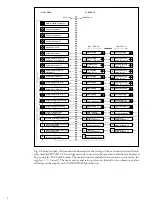
13
When the protective relay is operating under the
conditions specified in the section "Technical
data", the relay is practically maintenance-free.
The relay modules include no parts or compo-
nents subject to an abnormal physical or electri-
cal wear under normal operating conditions.
If the environmental conditions at the relay
operating site differ from those specified, as to
temperature, humidity, or if the atmosphere
around the relay contains chemically active gases
or dust, the relay ought to be visually inspected
in association with the relay secondary test or
whenever the relay modules are withdrawn from
the case. At the visual inspection the following
things should be noted:
- Signs of mechanical damage on relay modules,
contacts and relay case
- Accumulation of dust inside the relay cover or
case; remove by blowing air carefully
- Rust spots or signs of erugo on terminals, case
or inside the relay
On request, the relay can be given a special
treatment for the protection of the printed cir-
cuit boards against stress on materials, caused by
abnormal environmental conditions.
If the relay fails in operation or if the operating
values remarkably differ from those of the relay
specifications, the relay should be given a proper
overhaul. Minor measures can be taken by per-
sonnel from the instrument workshop of the
customer’s company, e.g. replacement of auxil-
iary relay modules. All major measures involv-
ing overhaul of the electronics are to be taken by
the manufacturer. Please contact the manufac-
turer or his nearest representative for further
information about checking, overhaul and re-
calibration of the relay.
Note!
Numerical protection relays contain electronic
circuits which are liable to serious damage due to
electrostatic discharge. Before removing a mod-
ule containing electronic circuits, ensure that
you are at the same electrostatic potential as the
equipment, for instance, by touching the relay
case.
Note!
Static protective relays are measuring instru-
ments and should be handled with care and
protected against moisture and mechanical stress,
especially during transport.
Maintenance
and repair
Spare parts
Motor protection relay module
SPCJ 4D34
Power supply and output relay module
U
aux
= 80...265 V ac/dc
SPTU 240R2 for NO trip contact
U
aux
= 18...80 V dc
SPTU 48R2 for NO trip contact
U
aux
= 80...265 V ac/dc
SPTU 240R3 for NC trip contact
U
aux
= 18...80 V dc
SPTU 48R3 for NC trip contact
Relay box, complete with input module
SPTK 4E3
Input module as separate part
SPTE 4E3
Bus connection module
SPA-ZC 17 or SPA-ZC 21
Ordering
numbers
Motor protection relay with make type tripping contact
SPAM 150 C
RS 641 014 - AA, CA, DA, FA
Motor protection relay with break type tripping contact
SPAM 150 C
RS 641 015 - AB, CB, DB, FB
The last letters of the ordering number indicate the rated frequency f
n
and
the auxiliary voltage range U
aux
of the relay as follows:
AA or AB equals f
n
= 50Hz and U
aux
= 80…265 V ac/dc
CA or CB equals f
n
= 50Hz and U
aux
= 18…80 V dc
DA or DB equals f
n
= 60Hz and U
aux
= 80…265 V ac/dc
FA or FB equals f
n
= 60Hz and U
aux
= 18…80 V dc
Power supply and output relay modules with make type tripping contact
SPTU 240R2
RS 941 021 - AA
SPTU 48R2
RS 941 021 - BA
Power supply and output relay modules with break type tripping contact
SPTU 240R3
RS 941 022 - AA
SPTU 48R3
RS 941 022 - BA






































